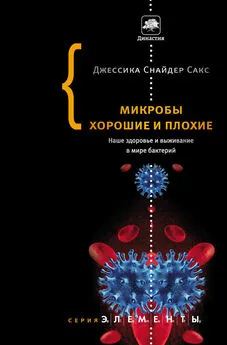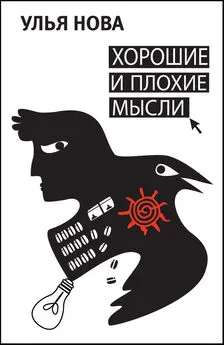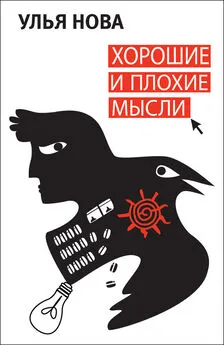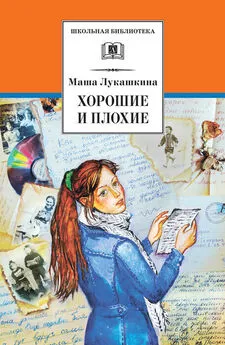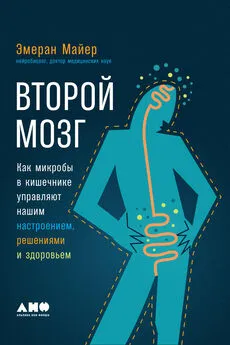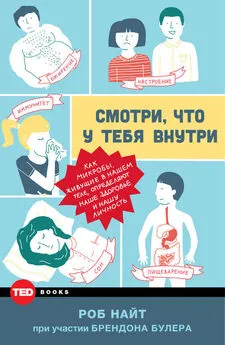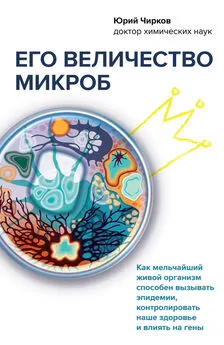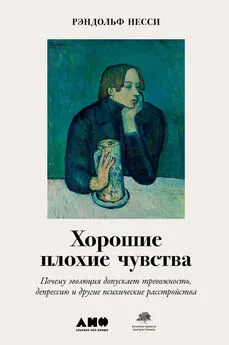Джессика Сакс - Микробы хорошие и плохие. Наше здоровье и выживание в мире бактерий
- Название:Микробы хорошие и плохие. Наше здоровье и выживание в мире бактерий
- Автор:
- Жанр:
- Издательство:Corpus
- Год:2015
- Город:Москва
- ISBN:978-5-17-093708-0
- Рейтинг:
- Избранное:Добавить в избранное
-
Отзывы:
-
Ваша оценка:
Джессика Сакс - Микробы хорошие и плохие. Наше здоровье и выживание в мире бактерий краткое содержание
Рассказывая о том, что в нашей войне с микробами пошло совсем не так, как надо, Джессика Снайдер Сакс раскрывает перед читателями складывающиеся сегодня представления о симбиотических отношениях человеческого организма и населяющих его микробов, число которых, кстати, превосходит число наших собственных клеток в девять раз! Кроме того, автор этой книги подает нам надежду на то, что в будущем люди научатся создавать и использовать антибиотики более благоразумно, и даже на то, что когда-нибудь мы сможем заменить противо-бактериальные и дезинфицирующие средства бактериальными, каждое из которых будет специально разработано так, чтобы обеспечивать наилучшую заботу о нашем здоровье.
Микробы хорошие и плохие. Наше здоровье и выживание в мире бактерий - читать онлайн бесплатно полную версию (весь текст целиком)
Интервал:
Закладка:
37 Johna DeNap et al., “Combating Drug-Resistant Bacteria: Small Molecule Mimics of Plasmid Incompatibility as Antiplasmid Compounds”, Journal of the American Chemical Society 126 (2004), 15402-15404.
38 Virve Enne et al., “Evidence of Antibiotic Resistance Gene Silencing in Escherichia coli”, Antimicrobial Agents and Chemotherapy 50 (2006), 3003-10.
39 Теоретически благодаря сорту “Флавр-Савр” полки продуктовых магазинов должны были наполниться более ароматными помидорами, потому что фермеры могли бы собирать их дозревшими (а не зелеными), не боясь, что они сгниют по дороге к покупателю. На деле же небольшого усиления аромата оказалось недостаточно, чтобы преодолеть тот мандраж, который вызывают у покупателей генетически модифицированные продукты.
40 D. G. White et al., “Inhibition of the Multiple Antibiotic Resistance (mar) Operon in Escherichia coli by Antisense DNA Analogues”, Antimicrobial Agents and Chemotherapy 41 (1997), 2699–2704.
41 C. Torres Viera et al., “Restoration of Vancomycin Susceptibility in Enterococcus faecalis by Antiresistance Determinant Gene Transfer”, Antimicrobial Agents and Chemotherapy 45 (2001), 973–975.
42 Rene Sarno et al., “Inhibition of Aminoglycoside 6’ – N acetyltransferase Type Ib-Mediated Amikacin Resistance by Antisense Oligodeoxynucleotides”, Antimicrobial Agents and Chemotherapy 47 (2003), 3296–3304.
43 WHO International Review Panel, “Impacts of Antimicrobial Growth Promoter Termination in Denmark: The WHO International Review Panel’s Evaluation of the Termination of the Use of Antimicrobial Growth Promoters in Denmark”, www.who.int / gfn / links / gssamrgro wthreportstory / en /.
44 McDonald’s Global Policy on Antibiotic Use in Food Animals, June 2003, www.aboutmcdonalds.com / etc / medialib / aboutMcDonalds / socialresponsiblity.Par.33574. File.dat / antibiotics_policy.pdf.
45 Richard Martin, “How Ravenous Soviet Viruses Will Save the World”, Wired, October 2003.
46 Peter Radetsky, “The Good Virus”, Discover 17 (November 1996); Thomas Hausler, Viruses vs. Superbugs (New York: Macmillan Science, 2006).
47 Интервью, взятые автором у Александра (Сандро) Сулаквелидзе в ноябре 2006 г.
48 Richard Stone, “Stalin’s Forgotten Cure”, Science 298 (2002), 728–731.
49 Amy Ellis Nutt, “Germs That Fight Germs: How Killer Bacteria Have Defeated Our Last Antibiotic”, Star-Ledger, December 9, 2003.
50 Письмо Кевина Смилли (Kevin Smeallie) автору от ноября 2006 г.
51 Anne Bruttin, Harald Brüssow, “Human Volunteers Receiving Escherichia coli Phage T4 Orally: A Safety Test of Phage Therapy”, Antimicrobial Agents and Chemotherapy 49 (2005), 2874–2878.
52 Thomas Broudy, Vincent Fischetti, “In Vivo Lysogenic Conversion of Tox- Streptococcus pyogenes to Tox+ with Lysogenic Streptococci or Free Phage”, Infection and Immunity 71 (2003), 3782–3786; Thomas Broudy et al., “Induction of Lysogenic Bacteriophage and Phage-Associated Toxin from Group A Streptococci During Coculture with Human Pharyngeal Cells”, Infection and Immunity 69 (2001), 1440–1443.
53 Steven Projan, “Phage-Inspired Antibiotics”, Nature Biotechnology 22 (2004), 167–168.
54 Phage Therapy Center, www.phagetherapycenter.com.
55 Jmg Liu et al., “Antimicrobial Drug Discovery Through Bacteriophage Genomics”, Nature Biotechnology 22 (2004), 185–191.
56 Qui Cheng et al., “Removal of Group B Steptococci Colonize the Vagina and Oropharynx of Mice with a Bacteriophage Lytic Eenzyme”, Antimicrobial Agents and Chemotherapy 49 (2005), 111117; J. M. Loeffler et al, “Rapid Killing of Streptococcus pneumoniae with a Bacteriophage Cell Wall Hydrolase”, Science 294 (2001), 2170–2172; R. Schuch et al., “A Bacteriolytic Agent That Detects and Kills Bacillus anthracis”, Nature 418 (2002), 884–889; D. Nelson et al., “Prevention and Elimination of Upper Respiratory Colonization of Mice by Group A Streptococci by Using a Bacteriophage Lytic Enzyme”, Proceedings of the National Academy of Sciences 98 (2001), 4107–4112.
57 Интервью, взятые автором у Винсента Фискетти в октябре – ноябре 2006 г.
58 Britta Leverentz et al., “Biocontrol of Listeria monocytogenes on Fresh-Cut Pro duce by Treatment with Lytic Bacteriophages and a Bacteriocin”, Applied and Environmental Microbiology 69 (2003), 4519–4526; Britta Leverentz et al., “Exami nation of Bacteriophage as a Biocontrol Method for Salmonella on Fresh-Cut Fruit: A Model Study”, Journal of Food Protection 64 (2001), 1116–1121.
59 Harald Brüssow, “Phage Therapy: The Escherichia coli Experience”, Microbiology 151 (2005), 2133–2140; T. R. Calloway et al., “What Are We Doing About Escherichia coli 0157: H7 in Cattle”, Journal ofAnimal Science 82 (2004), E93 – E99.
60 H. Steiner et al., “Sequence and Specificity of Two Antibacterial Proteins Involved in Insect Immunity”, Nature 292 (1981), 246–248.
61 T. Ganz et al., “Defensins, Natural Peptide Antibiotic of Human Neutrophils”, Journal of Clinical Investigation 76 (1985), 1427–1435.
62 Michael Zasloff, “Magainins, a Class of Antimicrobial Peptides from Xenopus Skin: Isolation, Characterization of Two Active Forms, and Partial cDNA Sequence of a Precursor”, Proceedings of the National Academy of Sciences 84 (1987), 5449–5453.
63 “Magainin, Shield Against Disease”, New York Times, August 9, 1987,
E24; см. также: Lawrence Altman, “Staying Ahead of Microbes: New Progress”, New York Times, August 4, 1987, C3.
64 Michael Zasloff, “Antimicrobial Peptides of Multicellular Organisms”, Nature 415 (2002), 389–395.
65 Y. Ge et al., “In Vitro Antibacterial Properties of Pexiganan, an Analog of Magainin”, Antimicrobial Agents and Chemotherapy 43 (1999), 782–788.
66 M. J. Goldman et al., “Human Beta-defensm-1 Is a Salt-Sensitive Antibiotic in Lung That Is Inactivated in Cystic Fibrosis”, Cell 88 (1997), 553–560.
67 L. Jacob, M. Zasloff, “Potential Therapeutic Applications of Magainins and Other Antimicrobial Agents of Animal Origin”, Ciba Foundation Symposia 186 (1994X197-223; Y. Ge et al., “In Vitro Susceptibility to Pexiganan of Bacteria Isolated from Infected Diabetic Foot Ulcers”, Diagnostic Microbiology and Infectious Disease 35 (1999), 45–53.
68 Department of Health and Human Services, Food and Drug Administration, Center for Drug Evaluation and Research, Anti-infective Drugs Advisory Committee, 66th meeting, March 4, 1999 (стенограмма).
69 Rexford Ahima et al., “Appetite Suppression and Weight Reduction by a Centrally Active Aminosterol”, Diabetes 51 (2002), 2099–2104.
70 Graham Bell, Pierre-Henri Gouyon, “Arming the Enemy: The Evolution of Resistance to Self-Proteins”, Microbiology 149 (2003), 1367–1375.
71 Jack Lucentini, “Antibiotic Arms Race Heats Up”, Scientist, September 8, 2003, 29.
72 Gabriel Perron, Michael Zasloff, Graham Bell, “Experimental Evolution of Resistance to an Antimicrobial Peptide”, Proceedings of the Royal Society B 273 (2006), 251–256.
73 Charlotte Schubert, “Microbes Overcome Natural Antibiotic”, news@nature.com, November 2, 2005, www.nature.com/news/20 05 / 051031 / full / news051031-5.html.
74 Rubhana Raqib et al., “Improved Outcome in Shigellosis Associated with Butyrate Induction of an Endogenous Peptide Antibiotic”, Proceedings of the National Academy of Sciences 103 (2006), 9178–9183.
75 Philip Liu et al., “Toll-like Receptor Triggering of a Vitamin D-Mediated Human Antimicrobial Response”, Science 311 (2006), 1770–1773.
76 Emma Harris, “Extreme TB Strain Threatens HIV Victims Worldwide”, Nature 443 (2006), 131.
1 Эпиграф: Theodor Rosebury, Microorganisms Indigenous to Man (New York: McGraw-Hill, 1962) 352–353.
2 Интервью, взятые автором у Виктора Низе (Victor Nizet) в ноябре 2006 г.
3 Jesse Wright et al., “The Agr Radiation: An Early Event in the Evolution of Staphylococci”, Journal of Bacteriology 187 (2005), 5585–5594.
4 Jesse Wright, Rhuzong Jim, Richard Novick, “Transient Interference with Staphylococcal Quorum Sensing Blocks Abscess Formation”, Proceedings of the National Academy of Sciences 102 (2005), 1691–1696.
5 K. A. Davis, “Ventilator Associated Pneumonia: A Review”, Journal of Intensive Care Medicine 21 (2006), 211–226.
6 Интервью, взятые автором у Ричарда Новика в ноябре 2006 г.
7 Phillip Coburn et al., “Enterococcus faecalis Senses Target Cells and in Response Expresses Cytolysin”, Science 306 (2004), 2270–2272.
8 Интервью, взятое автором у Майкла Гилмора (Michael Gilmore) в ноябре 2006 г.
9 George Liu et al., “Sword and Shield: Linked Group B Streptococcal B-hemolysin/cytolysin and Carotenoid Pigment Function to Subvert
Host Phagocyte Defense”, Proceedings of the National Academy of Sciences 101 (2004) 14491-14496.
10 Vivekanand Datta et al., “Mutational Analysis of the Group A Streptococcal Operon Encoding Streptolysin S and Its Virulence Role in Invasive Infection”, Molecular Microbiology 56 (2005), 681-95; John Buchanan et al., “Dnase Expression Allows the Pathogen Group A Streptococcus to Escape Killing in Neutrophil Extracellular Traps”, Current Biology 16 (2006), 396–400.
11 Thomas Louie et al., “Tolevamer, a Novel Nonantibiotic Polymer, Compared with Vancomycin in the Treatment of Mild to Moderately Severe Clostridium difficile-Associated Diarrhea”, Clinical Infectious Diseases 43 (2006), 411–420.
12 Личное сообщение Дэвида Дэвидсона (David Davidson, старший медицинский директор корпорации Genzyme) автору в ноябре 2006 г.
13 Критики вакцин, подавляющих патогенность, разработали математические модели, указывающие на то, что такие вакцины могут привести даже к повышению патогенности, предотвращая “наказание” патогенных штаммов смертью хозяев. Но результаты реального применения таких вакцин, например противодифтерийной, оказались прямо противоположными. См.: Benoit Soubeyrand, Stanley Plotkin, “Microbial Evolution: Antitoxin Vaccines and Pathogen Virulence”, Nature 414 (2001), 751–756.
Читать дальшеИнтервал:
Закладка:
